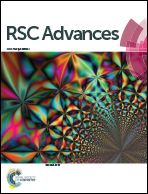Room temperature reaction of polycarbosilane with iodine under different atmospheres for polymer-derived silicon carbide fibres†
Abstract
The reaction of iodine with polycarbosilane (PCS) in air and N2 atmospheres at room temperature was investigated with the goal of limiting oxygen uptake during iodine curing, in order to fabricate SiC fibres with low oxygen contents. The investigation shows that the PCS fibres are well cured by iodisation even at room temperature, regardless of the presence of oxygen in the atmosphere. Although it was previously reported that the amount of oxygen incorporated is affected proportionally by the processing temperature, when PCS fibres were iodised in air at room temperature, they contained significant amounts of oxygen owing to the very long processing time despite the low temperature. On the other hand, when iodised in a N2 atmosphere, the fibres were successfully cured without oxygen uptake, thus demonstrating that iodisation under an oxygen-free atmosphere is a successful curing method for fabricating SiC fibres with low oxygen contents. During the cross-linking process, the iodine causes fragmentation of certain groups from the PCS polymer chains, which mostly contributes to the cross-linking between the chains, but leaves reactive sites that readily allow oxidation in air.



 Please wait while we load your content...
Please wait while we load your content...